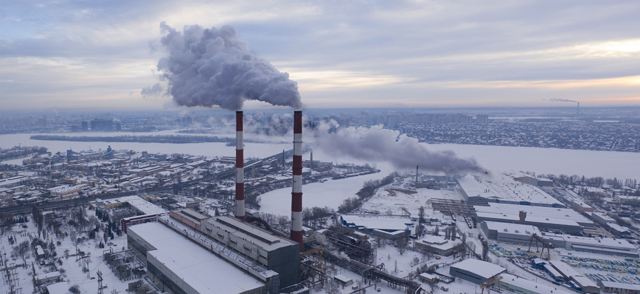If Countries Implement Paris Pledges with Cuts to Aerosols, Millions of Lives can be Saved
A strategic approach to reducing both greenhouse gas emissions and air pollution can reap major health and temperature benefits, according to new UC San Diego research
Published Date
By:
- Christine Clark
Share This:
Article Content
Aerosol reductions that would take place as countries meet climate goals could contribute to global cooling and prevent more than one million annual premature deaths over a decade, according to a new study from the University of California San Diego.
The landmark Paris Agreement of 2016 does not address emissions of aerosols — fine particulates like soot that cause pollution. Nonetheless, findings from the recent study authored by researchers at UC San Diego’s Scripps Institution of Oceanography and the School of Global Policy and Strategy suggests that aerosol accounting should be explicitly incorporated into international climate policy.
It is crucial because as countries implement their greenhouse gas reduction targets under the Paris climate agreement, their choices about which sectors to target will also reduce aerosols that are co-emitted, which will have major impacts to public health and global temperatures.
“Joint consideration of greenhouse gases and aerosols is critical,” said Pascal Polonik, a Ph.D. student at Scripps Oceanography and first author of the paper published in Earth’s Future. “Polluting particles, known as aerosols, are emitted in tandem with greenhouse gases but aren’t accounted for. While all greenhouse gas emissions might be thought of as unambiguously harmful, aerosols are more complicated. All aerosols are harmful to human health but they also often help counteract global warming by cooling the Earth’s surface.”
It is estimated that emissions of aerosols from burning fossil fuels like coal and diesel are responsible for nine million premature deaths worldwide. Though most aerosols have a cooling effect because they reflect sunlight, certain types, such as black carbon have a warming effect.
The UC San Diego team wanted to explore the tradeoffs countries would face by taking aerosols into consideration while concurrently making CO2 cuts to implement Paris pledges.
Their model provides a country-by-country breakdown of the impacts of aerosol reductions across the eight economic sectors which cause emissions. For each country, the authors consider three scenarios. The first scenario prioritizes air quality, targeting aerosol cuts to the “dirtiest” sectors that emit the most solid particles. The second prioritizes temperatures by targeting industries that emit aerosols that most contribute to warming and the third, dubbed the “politically expedient” approach, reduces emissions from all economic sectors equally.
Preventing as many as one million premature deaths per year by cutting emissions from certain sectors first
Under these three approaches, the authors find that by 2030, the three scenarios would yield prevention of as many as one million premature deaths every year and global temperature differences of the same magnitude as those from greenhouse gas reductions.
The study demonstrates the importance of domestic decisions for reducing emissions because making cuts to certain sectors can produce cleaner air and save more lives, or further reduce warming.
For example, the U.S. could choose to save more lives by targeting aerosol emissions in the industrial production, shipping, or residential/commercial sectors. It could also choose to limit warming more with cuts to the solvents, residential/commercial and waste sectors.
To the authors’ surprise, the third scenario, which may be most politically feasible to implement as policy, can lead to both more deaths and less cooling in certain places, such as Africa, China, the Middle East and South America.
“Implementing cuts equally and making each industry do their fair share may be the easiest way to implement climate policy in a democratic society like the U.S. where there are many competing political interests,” said co-author Kate Ricke, assistant professor with Scripps Oceanography and the School of Global Policy and Strategy. “However, there are real benefits to being thoughtful about how aerosols factor into climate policy outcomes. There may be big benefits to cutting emissions from certain sectors first.”
The research is critical to the U.S., as it is currently renegotiating its Paris agreement climate pledge.
“Our analysis does indicate some considerable tradeoffs between temperature and health outcomes that will need to be contended with in meeting near-term emission reductions goals,” said Jennifer Burney, the Marshall Saunders Chancellor’s Endowed Chair in Global Climate Policy and Research at the School of Global Policy and Strategy.
In India, for example, emission cuts in the transportation sector could save more lives, while cuts in the residential sector would produce more cooling.
The authors note that because the tradeoffs vary considerably for each region, countries are likely to have different priorities for weighing reduction of warming versus protection of public health when making climate policy decisions.
The conclusion, they emphasize, is that there are many ways to achieve the same magnitude of greenhouse gas reduction pledged in the Paris Agreement, but the aerosol emissions that “ride along” with those cuts may vary a lot depending on which sectors are targeted. As such, the authors write, “we believe that this is a strong case for explicitly considering aerosols when constructing climate policy.”
Share This:
Stay in the Know
Keep up with all the latest from UC San Diego. Subscribe to the newsletter today.




